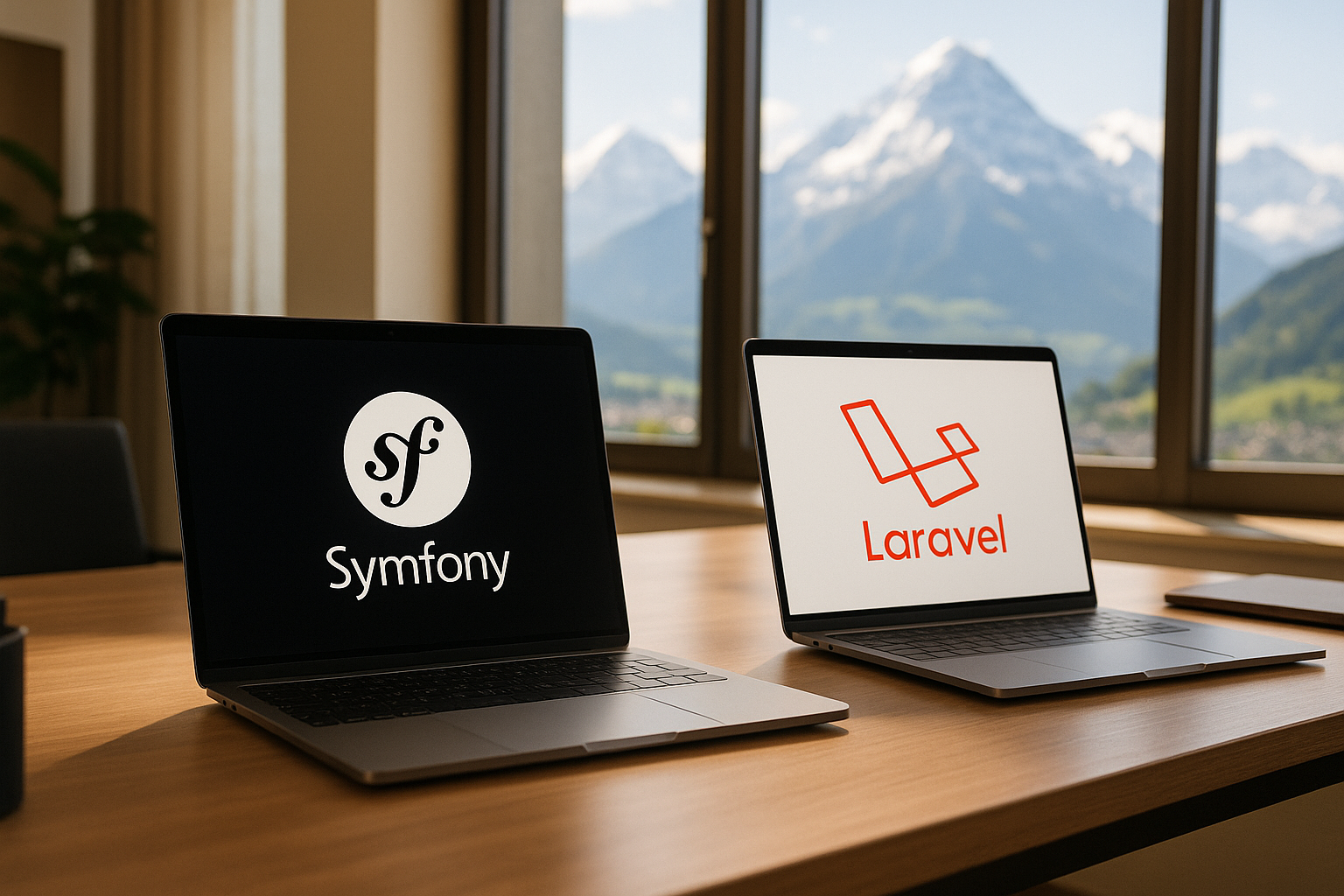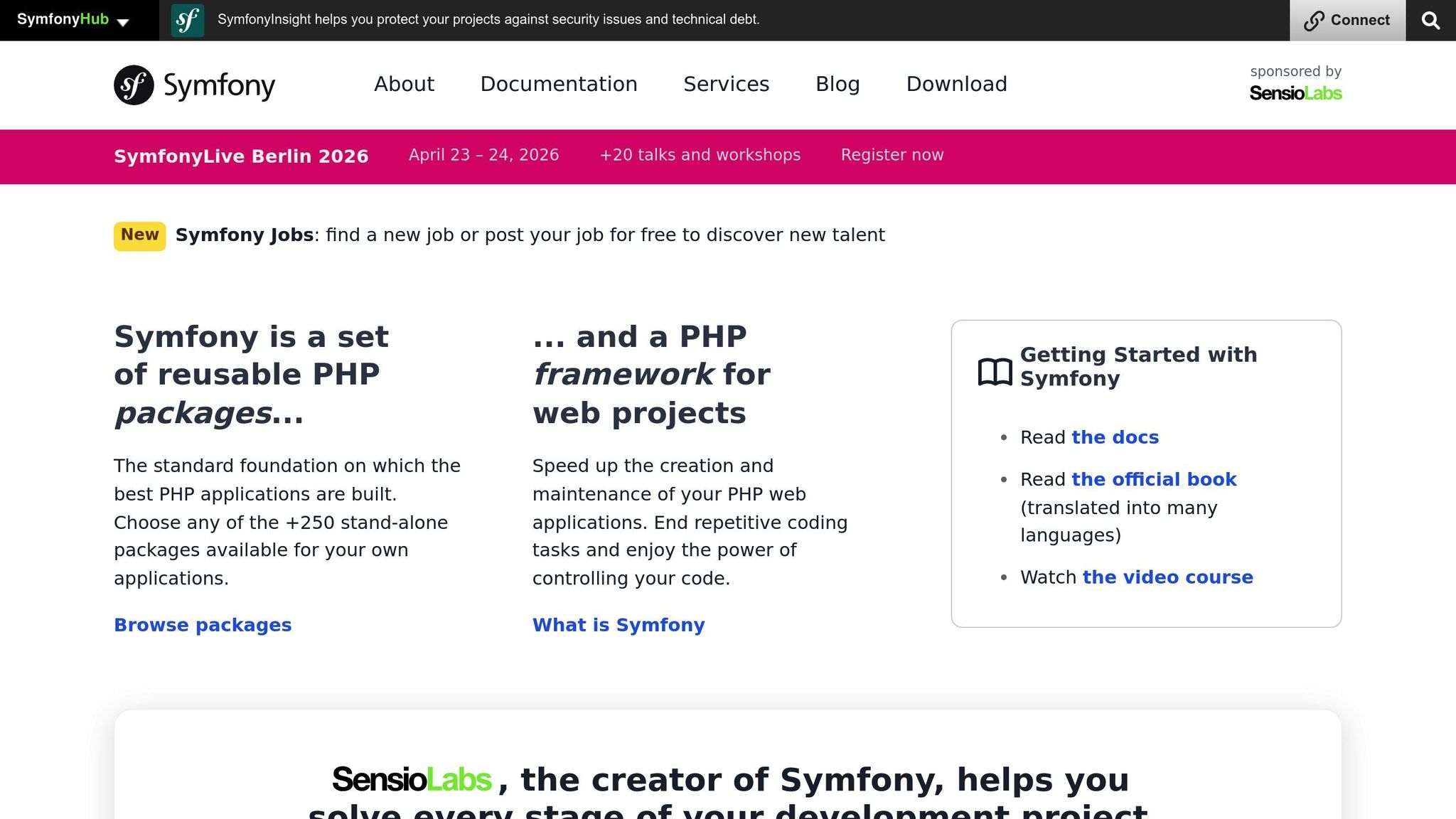
Symfony vs. Laravel: choosing the right PHP framework for your Swiss project
Symfony vs. Laravel: choose the right PHP framework for your Swiss project
Symfony or Laravel? If you are developing a , the choice of PHP framework is crucial to meet local requirements such as multilingualism, data protection standards, and performance. Here is a summary to help you choose quickly:
- Symfony: Ideal for complex and structured projects, such as enterprise applications or platforms requiring strict compliance with Swiss standards. More robust, but with a steeper learning curve.
- Laravel: Perfect for small to medium projects, such as startups or SMEs. Quick to implement, more accessible, and with an active community.
Quick comparison:
| Criterion | Symfony | Laravel |
|---|---|---|
| Project complexity | Large complex projects | Small to medium projects |
| Loading time | ~250 ms | ~60 ms |
| Multi-language support | Advanced (Translation component) | Standard (JSON and PHP files) |
| Swiss compliance | Easy to adjust | Requires additional configurations |
| Learning curve | More complex | More accessible |
| Popularity | 33,000 sites | 1.2 million sites |
In short: Choose Symfony for large-scale projects requiring advanced security and scalability. Opt for Laravel if you are looking for a quick and simple solution for medium-sized projects.
Symfony or Laravel? Practical comparison

Swiss requirements for web development
The in Switzerland requires meeting specific technical criteria, especially regarding multilingualism and compliance with local standards.
Support for Swiss languages and formats
With its multiple official languages, Switzerland requires precise management of multilingualism. Symfony and Laravel each offer suitable tools, although their approaches differ slightly:
| Functionality | Symfony | Laravel |
|---|---|---|
| Monetary format | Use of native NumberFormatter (e.g., CHF 1,234.50) | Custom helpers |
| Date format | Intl component (e.g., 16.05.2025) | Carbon extension |
| Numeric separators | Configuration via NumberFormatter (e.g., 1,234,567.89) | Localization-based settings |
| Multi-language routes | Examples: /fr/home, /de/startseite |
Middleware managing language in the URL |
A concrete example is Allianz Cinema. Their site, designed with Symfony, perfectly illustrates multilingual management, allowing redirection and display of content in multiple languages based on user preferences.
In addition to these formats, data security plays a crucial role in the Swiss context.
Swiss data protection standards
Switzerland imposes strict standards on data security, especially with the new Federal Act on Data Protection (FADP). Symfony and Laravel offer robust solutions to meet these requirements:
Symfony:
- Regular security audits
- Highly configurable security component
- Adopted by many Swiss companies
Laravel:
- Integrated CSRF protection and native encryption
- Simplified tools for access control
A striking example is Trivago, which uses Symfony to handle over 50 million daily searches. This demonstrates the framework's ability to ensure a high level of security while supporting massive data volumes.
For , it is essential to implement practices such as secure storage of personal data, logging access to sensitive information, consent mechanisms compliant with local regulations, and detailed documentation of data processing processes.
Technical structure: Symfony vs. Laravel
The technical structure of a PHP framework directly impacts the development and maintenance of projects in Switzerland. The architectural differences between Symfony and Laravel influence their ability to meet specific business needs. Let's explore how these two frameworks differ in their technical approaches.
Symfony's component system
Symfony is characterized by a modular architecture. Its component system allows developers to use only the necessary features, which can improve performance and optimize resources.
| Feature | Operation | Advantage |
|---|---|---|
| YAML Configuration | Separation of files by environment | Simplifies the management of complex configurations |
| Doctrine ORM | Robust database management | Ensures a clear separation between data and business logic |
| EventDispatcher | Event management via a listener system | Offers great flexibility in business processes |
A concrete example of Symfony's efficiency is its use by Drupal, a widely adopted CMS for complex and large enterprise systems.
Integrated tools for rapid development with Laravel
Unlike Symfony's modular approach, Laravel offers an all-in-one solution that emphasizes speed of development through its integrated tools. These features allow for the quick implementation of standard solutions.
| Functionality | Operation | Benefit |
|---|---|---|
| Eloquent ORM | Implements the Active Record pattern | Facilitates rapid and intuitive development |
| Blade | Lightweight template engine | Simplifies the integration of PHP into views |
| Middleware | Handles HTTP requests | Allows smooth and secure data management |
Laravel is particularly popular for small to medium-scale projects. Interestingly, the framework uses about 14 Symfony components, illustrating a certain complementarity between the two. These distinctions help better guide the choice of framework based on project size and specific needs in Switzerland.
Speed and scalability
For in Switzerland, speed and scalability are essential criteria. Let's compare the performance and adaptability of Laravel and Symfony here.
Speed tests: Comparative results
Tests conducted in different server environments revealed the following performances:
| Configuration | Laravel (seconds) | Symfony (seconds) |
|---|---|---|
| Apache (10 requests, 1 user) | 6.50 | 15.35 |
| Apache (1,000 requests, 10 users) | 202.66 | 638.56 |
| NginX (10 requests, 1 user) | 202.66 | 7.53 |
| NginX (1,000 requests, 10 users) | 211.85 | 658.73 |
In terms of capacity, Laravel can handle about 800 to 1,000 requests per second, while Symfony reaches between 1,000 and 1,200. These figures show that the choice of framework must align with the specific project needs.
Adaptation to growth
Numbers only tell part of the story. The frameworks' architectures play a key role in their ability to evolve. Symfony stands out for its modular structure and reusable components, making it an excellent choice for horizontal scalability, often necessary for large-scale applications.
On the other hand, Laravel favors an integrated architecture, ideal for vertical scalability. This approach makes it particularly effective for small to medium-sized projects, where rapid implementation is a major asset.
Multilingual support
In Switzerland, where multilingualism is a daily reality, integrating multiple languages into a web project is a necessity. This involves respecting local formats and Swiss standards, which play a key role in the success of any website or application.
Symfony translation tools
Symfony offers a powerful translation system through its Translation component, ideal for meeting the complex needs of the Swiss market. This framework relies on ICU MessageFormat syntax, which allows smooth management of variables and pluralization rules.
| Functionality | Description | Advantage |
|---|---|---|
| Message catalogs | Organization by translation domains | Simplifies maintenance |
| Automatic extraction | Identification of strings to translate | Saves time |
| ICU support | Advanced and flexible formats | Improves accuracy |
| Language detection | Automatic configuration by locale | Optimizes user experience |
For the fr-CH locale, Symfony automatically adjusts elements such as date formats, Swiss franc amounts (CHF), and numeric separators. This ensures full compliance with local standards without additional effort.
Symfony, with its modular and detailed approach, is particularly suitable for complex projects requiring extensive customization.
Laravel language features
Laravel, on the other hand, offers an integrated and intuitive solution for managing translations. This framework incorporates its localization system directly into the Blade template engine, offering great efficiency for medium-sized projects. It relies on two main methods for managing translations: PHP files in the lang directory and JSON files.
Some highlights of Laravel:
- Automatic publication of language files: Simplifies translation management.
- Integrated middleware for language switching: Allows smooth adaptation to local preferences via PHP-Intl.
- Pluralization syntax: Uses the
|character to easily manage linguistic variations.
JSON files, in particular, are an excellent solution for multilingual applications containing a large number of translatable strings. This is very practical for Swiss sites, where frequent content updates are often necessary.
In summary, while Symfony excels in precision for complex projects, Laravel stands out for its simplicity and efficiency for medium-sized needs. These two frameworks offer solid solutions to meet multilingual requirements in Switzerland.
Security standards
In Switzerland, data security is a priority, especially since the revision of the Federal Data Protection Act (LPD) in 2023. Symfony and Laravel offer powerful tools to ensure compliance with local requirements.
Symfony security options
Symfony provides a comprehensive security architecture, ideal for projects requiring a high level of compliance. Among its main components are:
| Component | Function | Advantage for compliance in Switzerland |
|---|---|---|
| Security Bundle | Authentication and authorization management | Alignment with data protection standards |
| Twig Engine | Automatic variable encoding | Effective protection against XSS attacks |
| Form Builder | Integrated CSRF protection | Form security |
| Doctrine ORM | Parameterized queries | Prevention of SQL injections |
Another notable advantage is Symfony's HTML Sanitizer, which cleanses rich content, a valuable asset for multilingual sites in Switzerland (French, German, Italian).
Laravel protection systems
Laravel, on the other hand, adopts a secure-by-default approach, making it a suitable choice for medium-sized projects. Here are some of its key features:
- CSRF protection: Using the
@csrfdirective, Laravel validates all requests to prevent cross-site request forgery attacks. - Database security: Eloquent ORM uses PDO binding with secure session parameters, configurable via
config/session.php. - Protection against attacks: The built-in rate limiting system effectively limits the number of requests, reducing risks.
Best practices for enhanced security
To maximize security, it is essential to:
- Regularly update the framework and its dependencies.
- Disable debug mode in production.
- Configure appropriate security headers.
- Monitor suspicious activities and conduct regular audits.
Finally, to comply with the LPD, it is recommended to host data in Switzerland. These measures enhance overall security and ensure that each project meets the strict standards of the Swiss market.
sbb-itb-454261f
Framework selection guide
depends on the complexity and scope of your project. Here are recommendations based on a thorough analysis of the features, performance, and security measures offered by each framework.
Symfony for large projects
Symfony is ideal for large-scale projects in Switzerland, especially due to its ability to meet high standards of compliance and security. Its modular structure ensures flexibility tailored to complex needs.
| Criterion | Strengths for
|
|---|